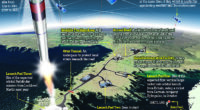Rewilding is core to conservation efforts around the world. In Australia’s threatened but intact deserts, where do people fit in with the strategy?
Martu desert country, north-east of Wiluna in Western Australia, is green right now. “We had a big rain in this area,” says Yvonne Ashwin, Martu woman and coordinator of the Martu rangers, who care for this country. Normally the desert is dry, the red soil tufted with spinifex and the brown bursts of mulga trees. But now the rains have been, and everything is lush and sprouting. The thriving desert life that usually conceals itself from the sun, heat and untrained eye is on full show; birds, insects, reptiles, mammals, flowering plants and trees.
Ashwin and her team of Indigenous rangers work across the vast Matuwa Kurrara Kurrara Indigenous protected area (IPA); nearly 570,000 hectares (1.4m acres) of native title-determined country of the Tarlka Matuwa Piarku Aboriginal Corporation. They crisscross its scorching hot landscape on car and foot, looking for tracks of bilbies and cats, scouting for clumps of invasive buffel grass and boxing glove cactus that they can dig out and burn, clearing road tracks of trees and old fencing wire, and using fire to tend to the landscape as their ancestors have done for tens of thousands of years.




